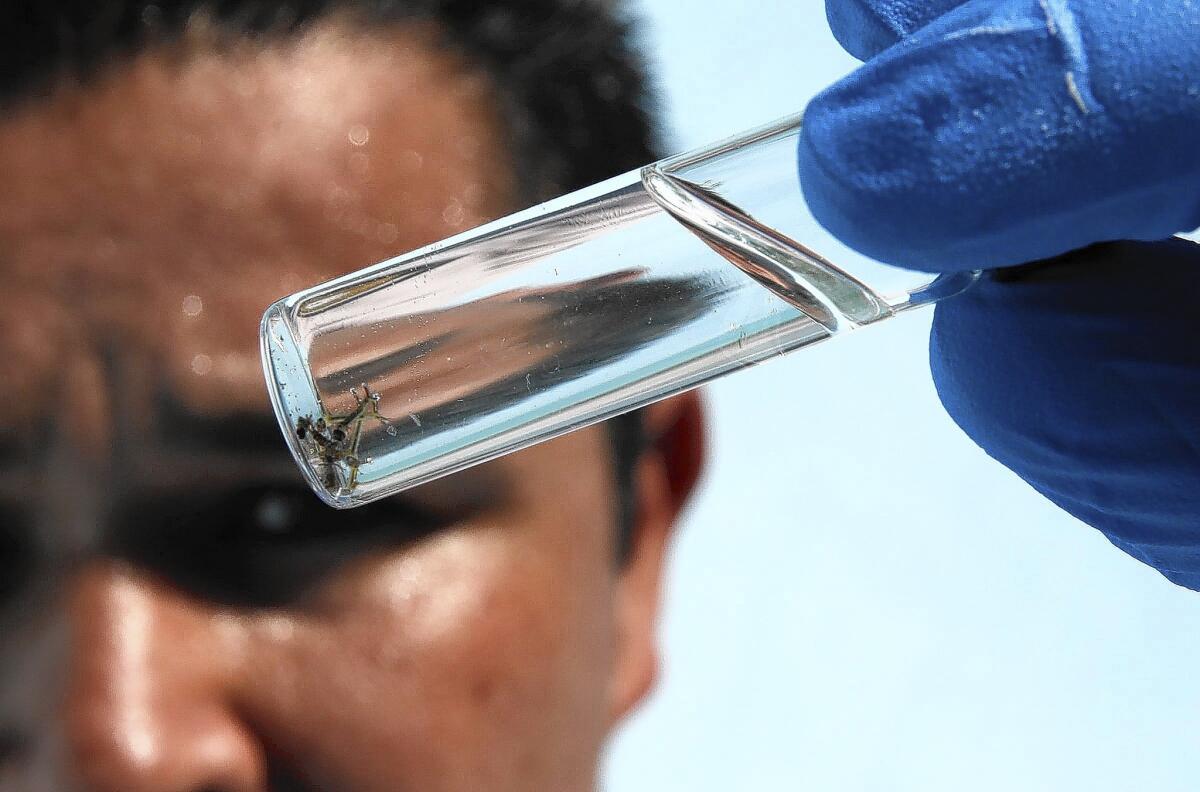In the battle against West Nile virus, people sometimes are the pests

- Share via
The aerial photograph showed there might be trouble, a small green spot in an otherwise dry swimming pool.
Eddie Garcia, an inspector for the Orange County Vector Control District, parked his white Toyota Tacoma across the street and approached the homeowner standing on the grass. Fidel Posos explained that the pool was empty because he was repairing the bottom.
Garcia walked into the backyard of the well-kept Buena Park home, down the pool steps and toward a puddle of murky green water that had settled around the drain. Using a tool that looked like a measuring cup attached to a broomstick, he pulled up a sample.
Just what he had suspected. “It’s cooking,” he said, filled with mosquito larvae.
In the best of times mosquitoes have few friends, but this year Orange County has seen an upsurge of cases of West Nile virus, which is transmitted by the insects, leading to an aggressive effort to track down the insects and kill them. Instead of passing out thousands of fly swatters, the vector control district relies on people like Garcia.
He placed a sample of the water from Posos’ pool in a tube for testing at the lab. Then he dropped a tablet of larvicide into the puddle and sprayed oil over the top to smother the bugs.
He will return in five months to make sure the pool is clean and the mosquitoes haven’t returned.
Possos’ pool was easy. But for those instances when the homeowner ignores vector control’s calls and notices or in those instances when they refuse to allow inspectors to check their yards, Orange County has now resorted to a new tactic: warrants.
Starting at the end of June, the district’s lawyer has gone into Superior Court to obtained warrants to inspect properties where owners have been uncooperative or unresponsive. The district received its third batch of warrants Aug. 19.
The warrants are a last resort. So far, leaving warrants at the house and following up with a postcard has been enough to get people’s attention. District officials said they have yet to call police to enforce the warrants.
“We suddenly get cooperation, and people say, ‘Come on in,’” said Larry Shaw, the district’s operations director.
In past years, inspectors would throw larvicide tablets or buckets of tiny mosquito fish, which eat the larvae, from a neighbor’s backyard or go into the yard itself if the gate was unlocked.
But Supreme Court decisions in the last year have made it tougher for government workers to enter private property, forcing vector control to resort to the warrants, said Colin Burns, the district’s attorney.
Orange County joins a few other mosquito killers in the state to use the tactic. Officials of the Coachella Valley Mosquito and Vector Control District say it was the first, starting in 2008.
Jeremy Wittie, scientific operations manager for the district, said that in most instances the warrants in Coachella Valley are used on abandoned or foreclosed property. In 2013, the warrants were used on 155 properties. The majority of the homes were vacant.
The courts have interpreted the law differently, depending on the area. Warrants are good for several months in the Coachella Valley but only two weeks in Orange County. And Coachella Valley inspectors can cut off the lock to a gate or call a locksmith to gain entry.
The Greater Los Angeles County Vector Control District, the largest in the county, is expecting to start using warrants in the spring, said Kelly Middleton, director of community affairs for the district.
The number of West Nile cases so far this year, in Orange County had increased to 74 as of Tuesday, compared with only two during the same period last year. A Seal Beach woman in her 80s and a Huntington Beach man in his 70s recently became the first people in the county to die from West Nile this year. Los Angeles County has reported 20 cases, including one death, this year, compared with 35 at this time last year.
At least nine people have died from the virus in California this year.
West Nile is up across the state. So far 129 cases have been reported compared to the five-year average of 46 at this time of year, according to the California Department of Public Health. This doesn’t include the most recent cases in L.A. and Orange counties.
Instances of West Nile can go up and down in different areas. Warmer temperatures, particularly at night, help mosquitoes develop more quickly. Because the disease travels from birds to mosquitoes to humans, a big year is often followed by a drop-off because surviving birds have developed immunity, said Vicki Kramer of the state Department of Public Health.
Although sometimes a neighbor will report a bad pool, Orange County relies on photos taken from a single-engine plane hired to survey the region. This marks the seventh year Orange County has used the plane.
Technicians analyze the photos for neglected pools or spas covered with algae — those that show up green instead of clear blue — which provide mosquito breeding grounds. An inspector will check whether the pool has been neglected or if the bottom has been painted or a tarp has been placed over it, fooling the photo technicians.
Orange County has monitored about 2,100 potentially bad pools this summer. Some turned out to be dry, others were treated with chemicals or mosquito fish. In 68 instances, the district was forced to get warrants.
An aerial survey two weeks ago found an additional 982 suspected bad pools that need to be inspected.
District officials say they can’t explain why the number of bad pools has risen to levels reached during the height of the recession. “There’s a saying among us that when money is tight, the first thing that goes is the pool man,” said Robert F. Cummings, director of scientific technical services.
Garcia, meanwhile, has become Orange County’s pool man.
At another Buena Park house that showed up on the photos, the owner had turned off his pool filter system because the pipes had broken. Although he had used pool chemicals, Garcia found larvae that had recently hatched. He tossed in four larvicide tablets and told the owner he’d be back in five months to check.
Twitter: [email protected]
